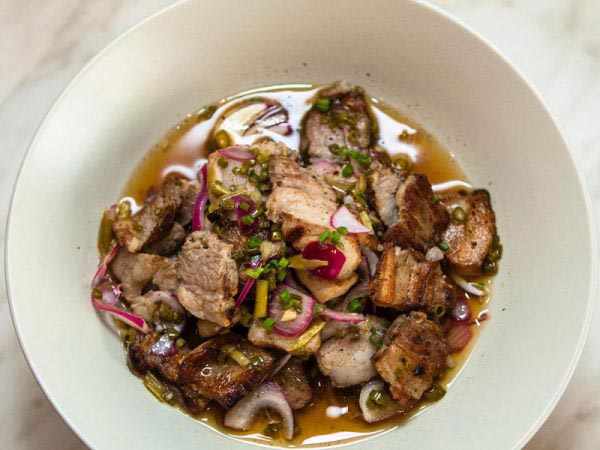
Asim Kilig: The Ultimate Guide to Filipino Vinegars

One of the most common observations, nay, even criticism, is that the Filipino Cuisine is too sour. While our neighboring countries have their hot and spicy food, we love our sour. We have a love story with our vinegars. Vinegars, with their sharp tang and pungent aroma, is as essential to the Filipino kitchen as the assorted spice lining up our pantry. With a rich and diverse culinary heritage, Filipino cuisine is full of bold and complex flavors, and vinegars are a key ingredient that elevates each dish to new heights.
Understanding Filipino Vinegars
The vinegars from the Philippines, often referred to as “suka,” have a role that goes beyond simply enhancing the taste of dishes. These tangy fluids are a reflection of the rich biodiversity found in this country, showcasing the abundance of plant and animal species that call it home. Each region has its own vinegar variety, reflecting the local flora and the community’s culinary preferences.
But there’s more to it than just that. The creation of these unique vinegars also demonstrates the ingenuity of the Filipino people. Using what they have at hand, they can transform simple natural resources into something truly special. This is not just about survival or sustenance; it’s about crafting distinct flavors that set their culinary creations apart.
These vinegars show the resourcefulness and creativity inherent in Filipino cuisine. They show how Filipinos use what nature provides them with to craft tastes that are not only unique but also deeply representative of their cooking culture.
Coconut Vinegar (Sukang Tuba)
From my earliest memories, Sukang tuba has been a constant. I was nurtured on this unique vinegar in the Southern Tagalog region where coconut trees stretch as far as the eye can see. This region’s bountiful coconuts yield an abundance of tuba, or coconut sap, which we use for everything from cooking to cleaning.
Tuba is a versatile staple in our Filipino lifestyle, giving us not just vinegar but also beverages like Tuba and Lambanog, a distilled spirit. Our Sukang Tuba is lighter than other vinegars due to its shorter fermentation process. It possesses a sweet and creamy texture that’s unlike any other vinegar you’ll taste. It ahs a higher acidity profile than sukang maasim but its sweetness more than makes up for it.
This distinctive flavor profile makes it a favorite for dipping sauces served with grilled seafood. It adds depth to dishes like Kinilaw, Inihaw na Manok (grilled chicken) and preserving balaw or alamang, enhancing their flavors and adding complexity.
Our ancestors were tapping coconut trees for sap long before Spanish colonization. They recognized the versatility of tuba early on, using it for both drinking and vinegar production.
What sets Sukang Tuba apart is its subtle sweetness that dances harmoniously with a well-balanced acidic bite. It’s an essential ingredient in Southern Tagalog cuisine, used daily in dishes such as Adobo, Kinilaw, and preserves like Atchara. My mother enjoys using sukang tuba, to create a flavorful spiced condiment known as sinamak. She adds chilies, garlic, ginger, black pepper, and salt to the vinegar and lets it sit for at least a week in the pantry at room temperature before using it.
Sukang Tuba is my favorite, its distinct depth and complexity resonate with me not only because it’s what I grew up with but also because it embodies the rich culinary traditions of my island.
Cane Vinegar (Sukang Puti/Sukang Maasim)
Upon my arrival in Manila, I quickly discovered that the vinegar of choice was Sukang Puti, also known as Sukang Maasim. This homegrown cane vinegar is a staple in Filipino kitchens. Crafted from sugarcane, it carries a unique sweetness that lends Filipino cuisine its characteristic tangy punch. This transparent, colorless liquid is typically born out of fermented sugarcane juice. Despite its name, its gentle acidity and fresh taste make it a versatile culinary tool, fitting for an array of dishes.
Sukang Puti plays a starring role in the national dish, Adobo, where it imparts a delicate sour undertone that counterbalances the richness of soy sauce and garlic. It’s also an integral part of marinades for meats and seafoods. Its application introduces a hint of tanginess without overshadowing the inherent flavors. In dipping sauces like Toyo’t Suka (soy sauce with vinegar), Sukang Puti injects an acidity that emphasizes the saltiness of the Toyo in stark contrast.
The origins of Sukang Puti production can be traced back to when sugarcane farming was introduced to the Philippines during Spanish colonial times. Sugarcane wine – a by-product of sugar production – was readily accessible and could be effortlessly transformed into vinegar through natural fermentation processes. Over centuries, Sukang Puti has entrenched itself as an essential element within Filipino gastronomy.
Whether it’s adobo or atchara, Sukang Puti or Sukang Maasim is employed across various dishes; its contribution elevates flavors to unparalleled depths.
Sukang Iloko
In the heart of the Ilocos region, nestled in the northern parts of the Philippines, exists a cherished culinary gem known as Sukang Iloco. This distinct vinegar is a byproduct of Basi, a powerful sugarcane wine that’s been part of our local culture for centuries. The creation process involves letting Basi age gracefully in traditional earthenware jars called “tapayans” for several years before it embarks on another prolonged fermentation journey to metamorphose into Sukang Iloco.
The resulting vinegar is a rich amber color and its taste… oh, its taste is an intricate dance of flavors! It perfectly marries sweetness with acidity and whispers delicate notes of caramel. The flavor profile of Sukang Iloko is smooth and gentle, making it an ideal base for marinades and vinaigrettes that we often prepare at home. Some people compare it to the flavor profile of Sherry Vinegar.
Its adaptability doesn’t stop there; it also shines as a key player in pickling processes and takes center stage as the favored dipping sauce in many households including mine. The story behind Sukang Iloco is deeply intertwined with Basi, a ceremonial beverage that carries significant cultural weight in our Ilocos region.
The roots of the Basi fermentation process can be traced back to indigenous populations, possibly even as far back as 2000 BC. Although the exact timeline remains shrouded in mystery, archaeological finds hint at fermented drinks being present in Southeast Asia thousands of years ago.
The Spanish colonization era saw an influx of sugarcane cultivation which indirectly boosted Basi production and consequently gave birth to Sukang Iloco. In my family’s kitchen, we love pairing Sukang Iloco with local delicacies like Longganisa (garlicky sausages) and Empanadas (fried turnovers filled with savory goodness). Every bite accompanied by this flavorful vinegar takes me on a nostalgic trip down memory lane to my grandmother’s kitchen in Pangasinan, where I first came upon this vinegar.
Palm Vinegar (Sukang Paombong)
Hailing from the town of Paombong, this vinegar is made from the sap of nipa palm. It stands out for its earthy undertones and but ultra sourness, Its high acidity flavor profile makes it perfect for pickling and is often paired with garlic, chilies, and other spices. They are used to make dishes known for their sourness, like pickled mangoes, papaya, ampalaya and fsour dishes like paksiw na isda or paksiw na lechon.
Spiced Vinegar (Sukang Maanghang)
Infused with a blend of chili, garlic, and onions, Sukang Maanghang is a favorite accompaniment for grilled meats and seafood. It adds a spicy kick that enhances the natural flavors of dishes without overpowering them.
The Sukang Pinakurat (a registered brand, contested because of its name), which is made from fermented coconut sap like the Sukang Tuba made its name for its sweet and spicy flavor which adds adds heat and complexity to our local tapa and longganisa, as well as grilled dishes.
Fruit Vinegars
Beyond the more common vinegars in Filipino cuisine, there’s a world of exciting options made from various fruits. Here are a few examples:
Sukang Mangga, or Mango Vinegar, is a delightful concoction. It’s born from the fermentation of Carabao mangoes, which are celebrated for their blend of sweetness and tang. When you taste Sukang Mangga, your palate is greeted by a lively fruitiness that carries just a hint of sweetness—a perfect partner to savory dishes without stealing the show. Picture it gracing your grilled meats and seafood, or adding an unexpected twist to your salads and marinades.
Next up is Sukang Pineapple—Pineapple Vinegar. This one starts life as fermented pineapple juice, and trust me when I say it brings a splash of tropical acidity right to your kitchen table. Its sweetness whispers rather than shouts, leaving room for a refreshing tartness to shine through. You’ll find this vinegar truly shines in dipping sauces for crispy treats like spring rolls and lumpia—it also adds an invigorating pop to stir-fries and chicken or pork marinades.
Then there’s the lesser-known but no less fascinating Sukang Balsa or Banana Vinegar. This one takes either fermented banana sap or overripe bananas as its foundation. The flavor profile? Intriguingly complex—it balances sweetness with an undercurrent of banana aroma and just the right amount of acidity. Sukang Balsa works wonders in stews and braises, where its unique personality pairs beautifully with rich and savory flavors.
Last but not least is Sukang Bignay—Bignay Vinegar—a specialty vinegar crafted from bignay fruit, small reddish berries native to my homeland—the Philippines. With its deep red color and a flavor that’s tart yet slightly sweet—with hints of berries and blossoms—it’s a versatile addition to any pantry. Imagine it enhancing dipping sauces, salad dressings or even acting as a base for cocktails.
Now bear in mind: These fruit vinegars aren’t quite as common as some other vinegars you might be used to. Their availability can vary depending on where you are and who’s making them. But for those of us with a taste for adventure in the kitchen, they open up a world of exciting possibilities, inviting us to examine the diverse universe of Filipino vinegars.
Culinary Applications of Filipino Vinegars
Filipino vinegars are versatile and can be used in a plethora of ways, from cooking to condiment to preservation. Here are some of the most common applications:
- Marinades: Vinegar’s acidity tenderizes meat and infuses it with flavor.
- Dipping Sauces: A base for sawsawan, vinegar is mixed with soy sauce, spices, and sometimes sugar.
- Pickling: Vinegar acts as a preservative, extending the shelf life of vegetables and fruits.
- Cooking: It adds acidity and brightness to dishes, balancing out flavors.
Fake Vinegar Brands
Unfortunately,m as much as there are fake honey, there are also fake vinegars. Which is surprising to me because it is so easy to make these vinegars. I realize though that some doesnt have access and have no choice but to buy them on groceries. Navigating the maze of vinegar labels in the Philippines can be a bit like playing detective. You need to stay on your toes, especially when it comes to products that casually list synthetic acetic acid in their ingredients. A quick scan through the Food and Drug Administration (FDA) website reveals an alarming number of brands marked as unfit for sale – all because of this very ingredient.
It’s like walking into a supermarket and finding familiar names such as Surebuy Cane Vinegar, Tentay Pinoy Style Vinegar, Tentay Premium Vinegar, Tentay Vinegar ‘Sukang Tunay Asim’, and Chef’s Flavor Vinegar on the blacklist. The common denominator? Synthetic acetic acid. It’s almost as if these brands took a shortcut around Mother Nature’s kitchen, bypassing the traditional fermentation process and ending up with a product that falls short of what genuine vinegar should be.
And here’s something else that gave me pause: A study by the Philippine Nuclear Research Institute (PNRI) disclosed that there are over 280 vinegar brands in our nation that could be labeled as ‘fake’. Why? Because they miss out on the natural fermentation process of acetic acid. That’s almost like calling a plastic plant real foliage!
So next time you’re at the grocery store, take an extra moment to examine those labels. Keep an eye out for suspicious ingredients and batch numbers – it might just save you from bringing home a bottle of counterfeit vinegar.
Now Let’s Get Cooking With Filipino Vinegars
So there you have it! Filipino vinegars, a proof of our country’s rich natural resources, are more than just kitchen staples. Each variety carries with it a piece of our reghional heritage and provides an insight into the Filipino way of life. These vinegars are not mere ingredients; they play a significant role in defining our national cuisine and a reflection of the region where they came from.
When you experience these vinegars, it is not just about the tang or sweetness on your tongue; it’s about appreciating what sets Filipino food apart and gaining a deeper understanding of our islands. I invite you to join me in discovering the wonders of Filipino vinegars. Now that you’re familiar with them, I encourage you to confidently use these vinegars to elevate your everyday meals into something extraordinary – their transformative power is truly remarkable.
Thank you for taking this journey with me through the world of Filipino vinegars. I hope you’ve gained some valuable insights along the way. The next time you come across a bottle of Filipino vinegar, may it remind you that like our archipelago, each type is unique and diverse in its own right.




